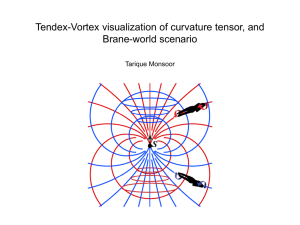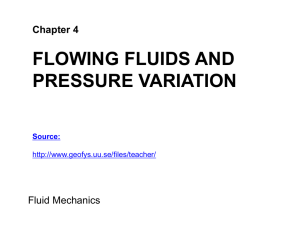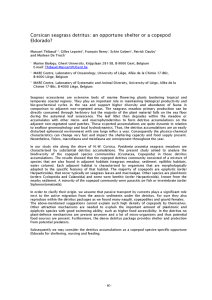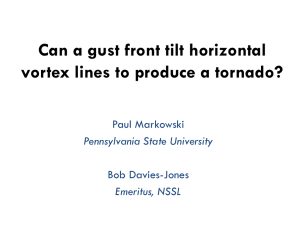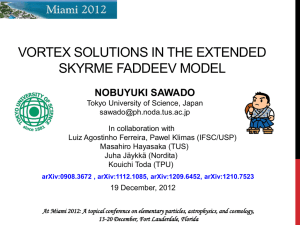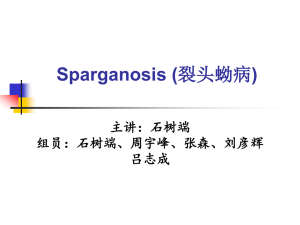Postprint text
advertisement
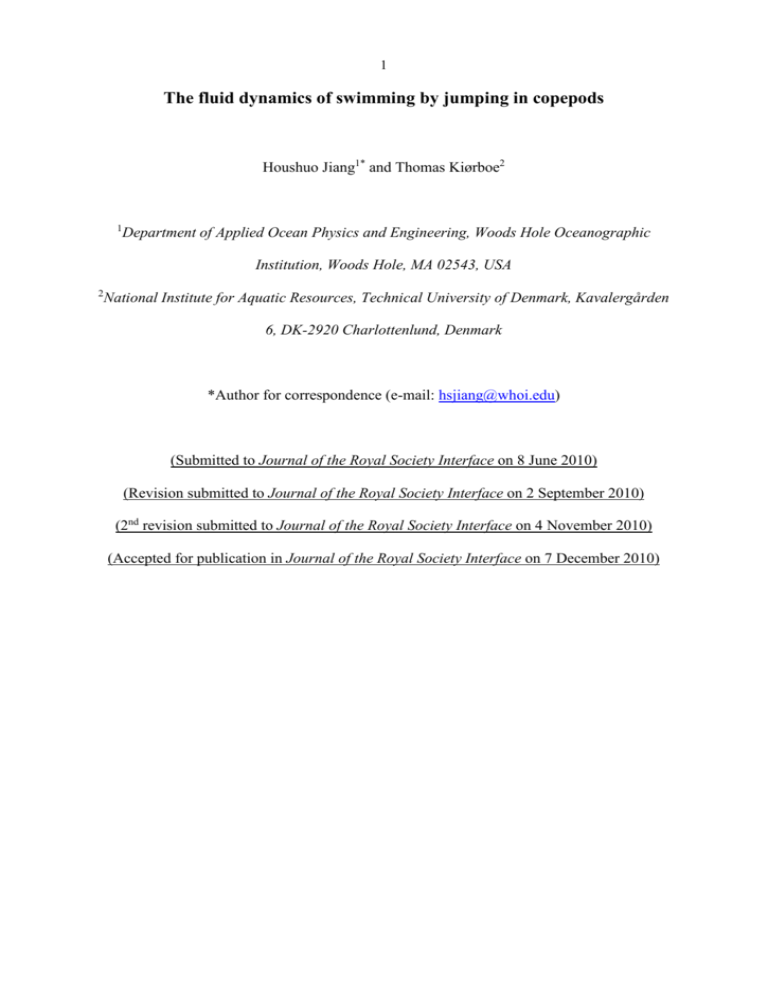
1 The fluid dynamics of swimming by jumping in copepods Houshuo Jiang1* and Thomas Kiørboe2 1 Department of Applied Ocean Physics and Engineering, Woods Hole Oceanographic Institution, Woods Hole, MA 02543, USA 2 National Institute for Aquatic Resources, Technical University of Denmark, Kavalergården 6, DK-2920 Charlottenlund, Denmark *Author for correspondence (e-mail: hsjiang@whoi.edu) (Submitted to Journal of the Royal Society Interface on 8 June 2010) (Revision submitted to Journal of the Royal Society Interface on 2 September 2010) (2nd revision submitted to Journal of the Royal Society Interface on 4 November 2010) (Accepted for publication in Journal of the Royal Society Interface on 7 December 2010) 2 ABSTRACT Copepods swim either continuously by vibrating their feeding appendages or erratically by repeatedly beating their swimming legs resulting in a series of small jumps. The two swimming modes generate different hydrodynamic disturbances and therefore expose the swimmers differently to rheotactic predators. We developed an impulsive stresslet model to quantify the jump-imposed flow disturbance. The predicted flow consists of two counterrotating viscous vortex rings of similar intensity, one in the wake and one around the body of the copepod. We showed that the entire jumping flow is spatially limited and temporally ephemeral owing to jump-impulsiveness and viscous decay. In contrast, continuous steady swimming generates two well-extended long-lasting momentum jets both in front of and behind the swimmer, as suggested by the well-known steady stresslet model. Based on the observed jump-swimming kinematics of a small copepod Oithona davisae, we further showed that jump-swimming produces a hydrodynamic disturbance with much smaller spatial extension and shorter temporal duration than that produced by a same-size copepod cruising steadily at the same average translating velocity. Hence, small copepods in jumpswimming are much less detectable by rheotactic predators. The present impulsive stresslet model improves a previously published impulsive Stokeslet model that applies only to the wake vortex. Key words: copepod jump, viscous vortex ring, impulsive stresslet, impulsive Stokeslet, hydrodynamic camouflage, non-dimensional ‘jump number’ 3 1. INTRODUCTION Planktonic organisms create water flows at the scale of their body as they move and feed. They generate feeding/swimming currents by rapidly beating their flagella, cilia or cephalic appendages more or less continuously. Or they may make instantaneous, shortlasting jumps to relocate, escape predators or attack prey (e.g. Buskey et al. 2002; Jakobsen 2001, 2002; Fenchel & Hansen 2006; Kiørboe et al. 2009), which in some cases may generate toroidal flow structures in their wake, as has been described for copepods (Yen & Strickler 1996; van Duren & Videler 2003; Kiørboe et al. 2010a). Finally, even when zooplankters do not move their appendages, cilia or flagella, they may sink passively, leading to flow passing around their body. It is of great relevance to investigate these small-scale biogenic fluid dynamical phenomena as they are related to and have implications for the various survival tasks of the plankters, such as feeding, nutrient uptake, predator avoidance, mating and signaling (for reviews see Strickler 1984, 1985; Yen 2000; Visser 2001; Jiang & Osborn 2004; Magar & Pedley 2005; Short et al. 2006; Kiørboe 2008). Specifically, zooplankters with different feeding and motility behaviors generate different hydrodynamic disturbances and therefore expose themselves differently to rheotactic predators. Quantitative characterization of these different hydrodynamic disturbances allows a mechanistic understanding of the (probably) different levels of predation risk faced by these zooplankters. Planktonic copepods, arguably the most abundant metazoans in the ocean (Humes 1994), swim either by continuously vibrating their feeding appendages, which results in a rather constant propulsion, or they use their swimming legs, which leads to sequences of small jumps. Continuous swimming by vibrating the feeding appendages is common among calanoid copepods that generate a feeding current. In contrast, ambush feeding copepods, mainly among the small cyclopoid copepods, do not generate a feeding current, but swim by sequentially striking the swimming legs posteriorly and by repeating this sequence at short 4 intervals (e.g. Strickler 1975; Morris et al. 1990). This leads to a very unsteady, erratic motion, which probably generates a hydrodynamic disturbance much different from that of a continuously swimming copepod. The purpose of this study is to compare the hydrodynamic signal generated by these two fundamentally different propulsion mechanisms in zooplankton, using copepods as an example. Several analytic solutions from classical fluid dynamics have previously been applied to investigate low-Reynolds-number flows created by small continuously moving plankters. For example, the solution of the Stokes flow associated with a steady point force was used to model the feeding current created by a negatively buoyant, stationary/hovering copepod (Tiselius & Jonsson 1990). The same authors also modeled the flow around a steadily sinking copepod using the well-known Stokes solution for the flow associated with a steadily translating sphere. Later, an analytic model of a negatively buoyant swimming copepod (hovering and free-sinking as special cases) was developed based on a linear combination of the Stokes flow around a stationary solid sphere and the Stokes flow owing to a point force external to the same sphere (Jiang et al. 2002; Jiang & Strickler 2007). This model separates the copepod main body resistance from the thrusting effect of the beating appendages and therefore has the ability to reproduce the major feeding/swimming current patterns that have been observed so far. However, these solutions to the steady Stokes flow equations cannot be applied to the intrinsic unsteady flows associated with plankters that swim by jumping because these are of an impulsive nature. Jumping plankters impart only brief and localized momentum to the surrounding water during short-lasting power strokes. The localized impulsive forcing exerted by the thrusting appendages (e.g. copepods) or membranelles (e.g. the jumping ciliate Mesodinium rubrum, Fenchel & Hansen 2006) will stop as soon as the power strokes are completed and the flow so created will decay because of viscosity. 5 There are few previous attempts to develop theoretical hydrodynamic models for the low-Reynolds-number unsteady flow associated with jumping plankton, even though jumping is a very common motility mode among both protozoan (Jakobsen 2001; Fenchel & Hansen 2006) and metazoan plankton (Horridge & Boulton 1967; Strickler 1975; Tiselius & Jonsson 1990; Svensen & Kiørboe 2000; Paffenhöfer & Mazzocchi 2002). Here, we develop such a model by taking into account the two characteristics of the jumping flow: namely, impulsiveness and viscous decay. We develop our model with jumping copepods in mind, but the model has wider application. It is well known that jumping copepods leave toroidal flow structures in their wake (Yen & Strickler 1996; van Duren & Videler 2003), and we previously developed an impulsive Stokeslet model for such viscous wake vortex rings (Kiørboe et al. 2010a). However, an additional vortex ring develops around the decelerating body, and in a typical repositioning jump of a millimeter-size copepod, the two rings are of similar intensity and opposite direction (figure 1a; Kiørboe et al. 2010a). We here present an impulsive stresslet model that describes the entire flow field and includes both vortex rings generated by the jumping copepod. We first compare the two theoretical models, and then apply the present impulsive stresslet model to observations of the kinematics of swimming in a small cyclopoid copepod, Oithona davisae. We compare the modeled flow for a jumpswimming copepod to the flow generated by a steadily cruising one and show that the hydrodynamic disturbance generated by the former has a much smaller spatial extension and temporal duration than that generated by the latter, suggesting that jump-swimming is a hydrodynamically quiet propulsion mode. 2. METHODS 2.1. Video observation We observed the swimming behavior of males of the cyclopoid copepod Oithona davisae (prosome length 0.3 mm) using high speed video (400 or 1900 frames s-1). Males, but 6 not females, of this species frequently swim when searching for females (Kiørboe 2007), and they swim using their swimming legs, not their feeding appendages. Animals were taken from our continuous culture and placed in ~100 ml aquaria. Light from a 50 W halogen lamp was guided through a collimator lens and the aquarium towards the camera, thus providing shadow images of the copepods. The camera (Phantom v 4.2 Monochrome) was equipped with lenses to produce fields of view of ~33 mm2 when filming at the high frame rate, or ~1515 mm2 when filming at the lower frame rate. At the low frame rate and low magnification we placed a mirror in the diagonal of the aquarium; by following both the image and the mirror image of the animals, we could reconstruct their 3-dimensional (3D) movement paths. When filming at the higher magnification, we selected sequences where the animal was moving in the view plane perpendicular to the camera. Selected video sequences (n = 18) showing one copepod moving were analyzed frame by frame, either semi-automatically using ImageJ or automatically using the particle tracking software LabTrack (DiMedia, Kvistgård, Denmark). The position of the animal was followed over time, allowing us to describe the temporal variation in move speed. At the higher magnification, we also noted the duration of the power stroke of the swimming legs in 4-6 beat cycles per animal. Observations of the flow field generated by the repositioning jumps of a different copepod (Acartia tonsa) and visualized using particle image velocimetry (PIV) were taken from Kiørboe et al. (2010a) for comparison with model predictions. 2.2. The impulsive stresslet model Using PIV, we have recently measured the flow fields imposed by copepods that performed repositioning jumps (Kiørboe et al. 2010a). Being approximately axisymmetric, a typical such measured flow field consists of two counter-rotating viscous vortex rings of similar intensity, one in the wake and one around the body of the copepod (figure 1a). The 7 wake vortex is generated owing to the momentum applied almost impulsively to the water by the rapid backward kick of the swimming legs; almost simultaneously but slightly delayed, the counter-rotating body vortex is generated owing to the oppositely directed momentum of equal magnitude paid back to the water by the forward moving copepod body. Here we consider the two rings as a whole system and describe their behavior using an impulsive stresslet model (figure 1b). Equations of the impulsive stresslet – An impulsive stresslet consists of two point momentum sources of equal magnitude (I, where is the mass density of the fluid and I the hydrodynamic impulse), acting synchronously in opposite direction and separated by distance (figure 1b). Each momentum source acts impulsively for a very short period of time formally represented by the Dirac delta function (t). The definition of the strength of the impulsive stresslet is 𝑀 = lim 𝜀→0, 𝐼→∞ 𝐼𝜀 = 𝑐𝑜𝑛𝑠𝑡𝑎𝑛𝑡 with [M] = L5T-1 for 3D flows. Vorticity (𝜔𝜙 ) and streamfunction (𝜓𝜙 ) for the above-described flow have been obtained in Stokes approximation (Afanasyev 2004): 𝑀𝑥𝑟 𝜔𝜙 = 32 𝜋3/2 (𝜈𝑡)7/2 𝑒 −𝜉 3 𝑀 𝑥 𝑟2 2 (2.1a) 𝜓𝜙 = − 2 𝜋3/2 (𝑥 2 +𝑟 2 )5/2 [− 𝑥 2 +𝑟 2 where 𝜉 = √ 4𝜈𝑡 √𝜋 erf(𝜉) 2 2 2 + 𝜉𝑒 −𝜉 (1 + 3 𝜉 2 )] , the kinematic viscosity, and the error function erf(𝜉) = (2.1b) 𝜉 −𝑦 2 𝑒 ∫ 0 𝜋 √ 2 𝑑𝑦. The solution is axisymmetric and independent of the azimuthal coordinate in the cylindrical polar coordinate system (x, r, ) (figure 1b). The components of velocity in the meridian plane are given by 1 𝜕𝜓𝜙 𝑢≡𝑟 𝜕𝑟 1 𝜕𝜓𝜙 𝑣 ≡ −𝑟 𝑀 𝑥 = 2𝜋3/2 (𝑥 2 +𝑟 2 )7/2 [(2𝑥 2 − 3𝑟 2 )𝐶 + 𝑟 2 𝐷] 𝜕𝑥 𝑀 𝑟 = − 2𝜋3/2 (𝑥 2 +𝑟2 )7/2 [(𝑟 2 − 4𝑥 2 )𝐶 + 𝑥 2 𝐷] (2.2a) (2.2b) 8 where u and v are the velocity components in the axial (x-) and the radial (r-) direction, respectively, 𝐶 = 3 [− √𝜋 erf(𝜉) 2 2 2 2 + 𝜉𝑒 −𝜉 (1 + 3 𝜉 2 )] and 𝐷 = −4𝜉 5 𝑒 −𝜉 . Viscous decay − Integrating 𝜔𝜙 (equation 2.1a) over one half of the meridian plane (e.g. x 0) where the vorticity is one-signed leads to a simple formula for viscous decay of circulation of the one-signed vorticity: +∞ Γ𝑥≥0 (𝑡) ≡ ∫0 +∞ ∫0 𝑀 𝜔𝜙 𝑑𝑥 𝑑𝑟 = 8𝜋3/2 (𝜈𝑡)3/2 (2.3) The hydrodynamic impulse of the one-signed vorticity satisfies: +∞ 𝐼𝑥≥0 (𝑡) ≡ 𝜋 ∫0 +∞ ∫0 𝜔𝜙 𝑟 2 𝑑𝑥 𝑑𝑟 = 𝑀 √4𝜋𝜈𝑡 (2.4) It is obvious that Γ𝑥≥0 (𝑡) + Γ𝑥<0 (𝑡) = 0 and 𝐼𝑥≥0 (𝑡) + 𝐼𝑥<0 (𝑡) = 0. Asymptotic analysis for finding spatial extension and temporal duration of the flow − At small time, the flow far field (i.e. >> 1) is approximately irrotational and behaves as: 𝑢= 3𝑀 𝑥(2𝑥 2 −3𝑟 2 ) 4𝜋 (𝑥 2 +𝑟 2 )7/2 (2.5a) 𝑣= 3𝑀 𝑟(4𝑥 2 −𝑟 2 ) 4𝜋 (𝑥 2 +𝑟 2 )7/2 (2.5b) The associated velocity magnitude is: 𝑈 ≡ √𝑢2 + 𝑣 2 = 3𝑀 √4𝑥 4 +𝑟 4 4𝜋 (𝑥 2 +𝑟 2 )3 (2.6) From equation (2.6), two lengths (denoted Rx* and Rr*) are formed to define the size of the domain over which the flow velocity magnitude is greater than a threshold velocity U*: Setting r = 0 leads to 3 𝑀 1/4 𝑅𝑥 ∗ = (2𝜋 𝑈 ∗) (2.7a) and setting x = 0 leads to 3 𝑀 1/4 𝑅𝑟 ∗ = (4𝜋 𝑈 ∗) (2.7b) 9 Asymptotic analysis at large time (i.e. 0) is too complicated to provide a formula for calculating the time t* after which the whole flow field is below U*. However, dimensional analysis together with numerical calculation using equation (2.2a, b) suggests a scaling relationship: 𝑆 𝑆∗ 𝑡 = 𝑓 (𝑡 ∗) (2.8a) 𝑀 1/2 𝑆 ∗ ≈ 0.476 𝑅𝑥∗ 𝑅𝑟∗ ≈ 0.868 (𝑈 ∗) 𝑡∗ ≈ 0.068 𝑀 1/2 (𝑈 ∗ ) (2.8b) (2.8c) where S is the area of influence defined as the area in the meridian plane, within which the flow velocity magnitude is greater than U*. A rheotactic predator is likely to perceive the prey-induced flow velocity magnitude (Kiørboe & Visser 1999) and, hence, this area is a measure of the encounter cross section of the copepod prey. The scaling relationship has been numerically determined and plotted (figure 2a); the hydrodynamic signal quantified as the area within which the induced flow velocity magnitude exceeds U* initially attains its maximum (i.e. S*) and then decays until dies out completely after t*. Both S* and t* depend on M/U* only. Translation of the vortices − The impulsive stresslet initially sets up an irrotational flow everywhere except at its application point where there exist two opposite-signed vorticity singularities (figure 3a). Both singularities diminish and the associated vorticities diffuse away from the application point as time goes on (figure 3b, c, d; electronic supplementary material, appendix movie S1). The coordinates of the two vorticity maxima evolve as: 𝑥𝜔 (𝑡) = ∓√2𝑡 (2.9a) 𝑟𝜔 (𝑡) = √2𝑡 (2.9b) and the two flow stagnation points (vortex centers) occur at: 𝑥𝑢 (𝑡) = ∓1.86326√𝑡 (2.10a) 10 𝑟𝑢 (𝑡) = √2 |𝑥𝑢 (𝑡)| = 2.63505√𝑡 (2.10b) Therefore, the vorticity maxima separate from the flow stagnation points as time goes on. 2.3. Analysis of the PIV flow data using the impulsive stresslet model To test whether the flow predicted by the impulsive stresslet model is a good approximation of the flow field associated with a copepod repositioning jump, we fitted by nonlinear regression the decay phase of the observed wake vortex circulation (Kiørboe et al. 2010a) to equation (2.3) subsequent to a virtual time origin t0: 𝑀 fitted Γ(𝑡) = 8𝜋3/2 [𝜈(𝑡−𝑡 0 )] 3/2 (2.11) We then compared the fitted impulsive stresslet strength, Mfitted, with that directly calculated from jump kinematics: Mmeasured = Umax × Vcopepod × Djump (2.12) where Umax is maximum speed attained by the copepod, Djump is the distance travelled by the copepod during a jump, the copepod body volume, Vcopepod, is 4/3 π η2 a3, and a half the prosome length, η = 0.38 the copepod aspect ratio, assuming the shape of a prolate spheroid with the long axis equal to the prosome length, L, and the short axes equal to η × L. 2.4. Brief description of a previously published impulsive Stokeslet model The impulsive stresslet model was worked out after we had published the Kiørboe et al. (2010a) paper, where we constructed an impulsive Stokeslet model to describe the wake vortex ring left behind a repositioning-by-jumping copepod. Unlike the impulsive stresslet model, the impulsive Stokeslet model did not consider the interaction between the wake vortex ring and the body vortex ring. Here, we recapitulate some equations from the impulsive Stokeslet model for comparing the two models (figure 2). An impulsive Stokeslet consists of a point momentum source of magnitude ρI acting impulsively for a very short period of time formally represented by δ(t) (figure 1c). [I] = L4T-1 11 for 3D flows. Similar to the impulsive stresslet model, the scaling relationship for the area of influence, S, is: 𝑆 𝑆∗ 𝑡 = 𝑔 (𝑡 ∗) (2.13a) 𝐼 𝑆 ∗ ≈ 0.385 (𝑈 ∗) 1 2 𝐼 𝑡 ∗ = 4 (3 𝑈 ∗) 2/3 (2.13b) 2/3 (2.13c) The scaling relationship has been numerically determined and plotted (figure 2a). The model parameter I (the hydrodynamic impulse) can be estimated as: Imeasured = Umax × Vcopepod (2.14) 3. RESULTS 3.1. Jump-swimming kinematics Jump-swimming consists of a sequence of small jumps: the swimming legs are pushed posteriorly in power strokes, one after the other, and returned all at the same time, and the sequence is repeated at an average frequency of 21.5 Hz (table 1; electronic supplementary material, appendix movie S2). This leads to a highly fluctuating velocity: short bursts with speeds of up to 30-50 mm s-1 during power strokes of 7.2 ms duration on average and interrupted by long pauses, resulting in an average propulsion speed of 8 mm s-1 (table 1; figure 4). The individual jumps resemble repositioning, attack or escape jumps in this species (Kiørboe et al. 2010b), but they differ in the phase lag between individual swimming legs: near 90° in escape and attack jumps, but only between 30 and 60° for the swimming jumps (i.e. the legs are closer to one another) (figure 5). As a consequence, the average forward movement is only a little more than 1 body length for a swimming jump (0.375 mm or 1.25 body lengths, table 1), whereas it is near 2 body lengths for repositioning, escape and attack jumps (Kiørboe et al. 2010b). 3.2. The impulsive stresslet flow field 12 The imposed flow predicted by the impulsive stresslet model consists of two counterrotating viscous vortex rings that expand and decay as exact mirror image about the r-axis (figure 3; electronic supplementary material, appendix movie S1). This is consistent with our PIV observation of the flow field around a copepod during a repositioning jump in that the spatial extension and temporal evolution of the two vortex rings, one in the wake and one around the forward moving body, are similar (Kiørboe et al. 2010a). The impulsive stresslet model provides a satisfactory least-squares fit to the decaying phase of the observed circulation of the wake vortex (figure 6), and the stresslet strengths estimated from such fits of 12 observed flow fields, Mfitted (equation 2.11), are in good 1:1 correspondence with stresslet strengths estimated from the kinematics of copepod jumps, Mmeasured (equation 2.12) (figure 7; table 2). Thus, equation (2.12) allows for using the measured jump kinematics to estimate the impulsive stresslet strength, M, and therefore determine the entire jumping flow. The model also provides a satisfactory least-squares fit to the decaying phase of the observed circulation of the vortex around the copepod body, similar to the fit to the circulation of the wake vortex but with a time lag slightly shorter than the beat duration of the power stroke (figure 6). For both vortex rings associated with a copepod repositioning jump, the positions of vorticity maximum separate increasingly from the flow stagnation points as time goes on (Kiørboe et al. 2010a). Such separation, which is mainly due to viscous diffusion, is predicted by equations (2.9a, b) and (2.10a, b) and is a characteristic feature of viscous vortex rings. 4. DISCUSSION 4.1. The flow field Schlieren observations have long revealed the toroidal flow structures left by jumping copepods (e.g. Kerfoot et al. 1980). We previously developed a theoretical hydrodynamic model (impulsive Stokeslet) that described the wake flow (Kiørboe et al. 2010a); here, we 13 have presented a model that includes the flow that develops around the body of the jumping copepod (impulsive stresslet). It is relevant to here first compare the two models. Owing to fluid viscosity, the flow fields of both models decay immediately after the application of the impulsive forcing. The scaled area of influence, S/S*, decreases monotonically and in a very similar way as a function of the scaled time, t/t*, in the two models (figure 2a), indicating that viscous decay is the primary effect in both models. To compare the two models more explicitly, we applied both to an average 1-beat-cycle repositioning jump of the copepod Acartia tonsa from our previous PIV observations (table 2). For small signal threshold velocities (i.e. U* < 0.5 mm s-1), the signal disappearance time, t*, is smaller for the impulsive stresslet model than for the impulsive Stokeslet model (figure 2b). This difference is due to partial mutual vorticity cancellation by the two counter-rotating viscous vortices, which is ignored by the impulsive Stokeslet model. For the same reason, the wake flow velocity distribution, U(x), directly behind the application point of the forcing (i.e. x = 0) at the time immediately after the onset of the forcing (i.e. t = 0+) is predicted to decline faster by the stresslet than by the Stokeslet model (figure 2c). Thus, on top of viscous decay, which is the primary effect, partial mutual cancellation of oppositely signed vorticities in the impulsive stresslet model causes the imposed flow to attenuate faster, both spatially and temporally. Finally, the hydrodynamic impulse, I, of the wake vortex, estimated from the attenuation of vortex circulation using PIV observations and the impulsive Stokeslet model, somewhat underestimates the maximum density-specific momentum of the jumping copepod (figure 2d in Kiørboe et al. 2010a), while the impulsive stresslet strength, M, shows a better 1:1 correspondence between that estimated from circulation decay and measured directly from jump kinematics (figure 6; table 2). Again, this difference can be ascribed to the ignorance of partial vorticity cancellation by the impulsive Stokeslet model. 14 Thus, the impulsive stresslet model represents an improvement over our previous impulsive Stokeslet model, both by considering the interaction between the two vortex rings and, mainly, by describing the entire imposed flow field, not only the wake flow. The impulsive stresslet model indeed does provide a good approximation of the entire flow associated with a copepod repositioning jump as evidenced both by the good correspondence to PIV observations (figures 6-7) as well as to computational fluid dynamics (CFD) simulations (Jiang & Kiørboe 2010). The strength of the impulsive stresslet is the only parameter involved, and can be estimated as the product of the body volume, maximum jump speed, and total jump distance of the copepod. Therefore, accurate measurement of jump kinematics is sufficient to estimate the entire flow field. Both spatial extension and temporal duration of the imposed hydrodynamic signal scale with (M/U*)1/2 (equation 2.8). Because the scaling equation (2.13) of the impulsive Stokeslet model cannot be directly applied to the entire repositioning-by-jumping flow, in our previous work we had to fit the PIV-measured flow velocity data to the general scaling that relates the initial area of influence, S, to (I/U*)2/3 in order to determine the coefficient in front of the scaling (Kiørboe et al. 2010a). Based on this, we predicted that the imposed hydrodynamic signal is much less for an ambush-feeding than a cruising or hovering copepod for small individuals in a timeaveraged sense. In the following, we use the more accurate impulsive stresslet model to show that this prediction holds true at any instant in time. 4.2. Swimming-by-jumping in Oithona is hydrodynamically quiet swimming. The flow fields generated by motility or feeding currents are likely to shape, to a certain degree, the feeding and motile behavior of planktonic organisms. We have previously discussed how the induced flow field may serve as a signal to predators, and how different feeding behaviors consequently may expose zooplankters differently to predation risk depending on their size and on the predation landscape (Kiørboe et al. 2010a). Continuous 15 feeding currents and steady cruising generate momentum jets, while unsteady jumps generate vortex rings. The latter attenuate spatially much faster than the two former flow fields and are, in addition, by default intermittent. Thus, the impulsive stresslet model predicts that the flow velocity induced by a jumping plankter decreases with distance, d, as d-4 (equation 2.6). (Note that the impulsive Stokeslet predicts d-3.) For a cruising neutrally buoyant plankter (modeled as a steady stresslet; appendix A) or a negatively buoyant hovering one (modeled as a steady Stokeslet) induced flow speeds decline with, respectively, d-2 and d-1 (e.g. Jiang et al. 2002). Despite the higher induced peak flow velocity magnitudes, jumps may thus produce significantly weaker hydrodynamic signals to predators over a large range of body sizes. This is illustrated by the hydrodynamic signals generated by the two different mechanisms of propulsion in copepods, erratic jump-swimming and continuous cruising, as predicted by the impulsive stresslet model and a steady stresslet model, respectively: the flow velocity magnitude as well as the deformation rate of the wake flow attenuate much faster spatially for jump-swimming Oithona davisae males than for a like-sized copepod cruising steadily at the same average velocity, and both flow velocity and deformation rate are smaller for the jumpswimmer just 1-2 body lengths (0.5 mm) behind the copepod (figure 8a, b). The likely size of the smallest energy containing eddies of small-scale oceanic turbulence is Le = 2 (3/E)1/4, and the associated turbulent shear is t E (e.g. Lazier 10 & Mann 1989). If the kinematic viscosity ~ 10-6 m2 s-l and the turbulent kinetic energy dissipation rate E ~ 10-7 W kg-1, then Le ~ 10 mm and t ~ 0.18 s-1. Thus, the hydrodynamic signal owing to jump-swimming by the male copepod Oithona davisae is probably overwhelmed by the smallest turbulent eddies. Rheotactic predators are more likely to respond to the flow velocity than to the deformation rate of the flow generated by their prey (Kiørboe & Visser 1999), and the area of 16 influence (S, within which the imposed flow velocities exceed a threshold velocity, U*) of the moving copepod is therefore a measure of its hydrodynamic ‘visibility’ to such predators (encounter cross section). S is substantially smaller for the jump-swimming copepod than for a same-size copepod cruising steadily through the water at the same average translating velocity (figure 8c). This applies at any one point in time but the discrepancy becomes even more pronounced when expressed as time-averaged signals; the area of influence owing to steady cruising is ~5 times larger than the time-averaged area of influence owing to jumpswimming (figure 8c). Thus, despite the higher induced peak flow velocity magnitudes but because of the rapid spatial and temporal attenuation as well as the intermittent nature, jumps may produce significantly weaker hydrodynamic signals to predators. This suggests that the adoption of erratic jump-swimming is an adaptation to moving quietly and reducing detection by rheotactic predators. This is consistent with the observation of Yen (1985) that a rheotactic predatory copepod (Euchaeta elongata) had higher predation rates on the cruising copepod Pseudocalanus sp. than on the similarly sized jumping copepod Acartia clausii. For those copepods that swim by means of the feeding appendages, ‘swimming’ may thus be interpreted as a ‘by-product’ of feeding. 4.3. Hydrodynamic ‘camouflage’ An interesting question is why Oithona davisae males in jump-swimming reduce the phase lag between individual swimming legs and consequently the jump distance relative to that of repositioning, escape and attack jumps. We suggest that a jump-swimming copepod adjusts its jump length to equal the distance that the vortex around its body travels within one jump interval because this generates the best hydrodynamic camouflage. The vortex traveling distance is calculated according to equation (2.9a) and the observed average jump interval T (= 1/21.5 s) as √2𝑇 ~ 0.35 mm, which is indeed close to the average jump distance 17 observed, 0.38 mm (table 1). Figure 9 shows the flow field consequence if the jump distance is roughly equal to the vortex traveling distance. The center of the vortex ring pairs of the next jump occurs at the vorticity maxima of the previous vortex around the copepod body. This way, vortex ring pairs are regularly spaced and do not deviate much from their canonical form; it looks like a train of equally distanced stepping stones; one disappears at the back and the other emerges in front. In doing so, predators may misread the vortex rings as rings created by physical processes (turbulence), because the background flow field is likely to be made up of many such viscous vortices. This is because any unbounded flow that has net linear momentum (or momentum pair) eventually decays to the unique vortex ring solutions of the Stokes equations (Phillips 1956; Shariff & Leonard 1992). 4.4. Jet or vortex: the jump number If intermittent jump-swimming is a means of moving quietly and because the formation of viscous vortex rings is essential to this effect, it becomes relevant to decide what degree of intermittency is required for the induced flow field to be characterized by viscous vortex rings (figure 3) rather than by momentum jets (Appendix A). Sozou (1979) showed that the Stokes flow developing subsequent to the instantaneous application of a constant point force initially has a dipole-like structure (i.e. develops a vortex ring), and this applies as long as the 4𝜈𝑡 dimensionless parameter 𝜆 = √𝑥 2 +𝑟 2 << 1. This inspires the definition of a dimensionless ‘jump number’ to characterize the impulsiveness of the jump behavior: 𝜏 𝑁jump ≡ 𝐿2 /(4𝜈) (4.1) where is the duration of the power stroke and L the prosome length. Njump is the ratio of two time scales (beat duration and viscous time scale), and for values of order 1 or less, the induced flow will be in the form of a viscous vortex ring, while for very large values, the induced flow will be in the form of a jet. Using CFD numerical simulations, we have shown 18 that viscous vortex rings do form from copepod jumps for the jump numbers of the order of 1 or less (Jiang & Kiørboe 2010). The duration of the power stroke does not have a very clear scaling with size, as suggested from the data compiled for various zooplankters, but the jump number increases dramatically with declining size (figure 10). This suggests that there is a critical minimum size below which plankters cannot create vortices and hence move quietly by jump-swimming. From equation (4.1) and assuming a power stroke of 1-10 ms duration as typical for plankters, this threshold is of order 0.05-0.2 mm. Thus, most copepods can create vortices, copepod nauplii are questionable and protozoa cannot. This is consistent with observations of toroidal flow structures generated by copepods (Yen & Strickler 1996; van Duren & Videler 2003; Kiørboe et al. 2010a), and with the lack of such structures for the jumping ciliate Mesodinium rubrum (Jiang 2010). 4.5. Viscous versus inviscid vortex rings in the context of animal propulsion Copepod jumps generate viscous vortex rings whose properties are strikingly different from the inviscid vortex rings typically considered in the context of animal propulsion (e.g. Triantafyllou et al. 2000; Anderson & Grosenbaugh 2005; Fish & Lauder 2006). In a viscous vortex ring, owing to viscous diffusion, the vorticity maximum point separates increasingly from the flow stagnation point as time goes on (Phillips 1956). In an inviscid vortex ring (e.g. Hill’s spherical vortex; Lim & Nickels 1995), both points move through the fluid with the same constant velocity and the form of the vortex ring does not change with time. A (nearly inviscid) vortex ring generated from the traditional piston-cylinder arrangement is due to rolling-up of a vortex sheet that separates at the nozzle edge (e.g. Didden 1979); when longlasting momentum as well as fluid volume flux are issued out from the piston-cylinder arrangement, there exists a vortex ring formation process that physically limits the size of the generated vortex ring (Gharib et al. 1998; Linden & Turner 2001). Here, in contrast, viscous 19 vortex rings are generated because of short-lasting localized momentum forcing only (e.g. Voropayev & Afanasyev 1994), and therefore there is no such vortex ring formation process. Both the impulsive stresslet model and the impulsive Stokeslet model provide tractable theoretical frameworks for describing not only the copepod jumping flows but also the impulsively created flows by many other ecologically important marine organisms, including most zooplankton, small fish larvae and even krill operating in the low-Reynolds-number regime (Re typically ranging from 0.1 to several hundreds). Both models may also find their applications in small insect hovering flights, which are of a similar low-Reynolds-number range. The biological and ecological implications of viscous vortices have hitherto been very little studied. ACKNOWLEDGMENTS This work was supported by National Science Foundation grants NSF OCE-0352284 & IOS-0718506 and an award from WHOI’s Ocean Life Institute to H.J and by grants from the Danish Research Council for independent research and the Niels Bohr Foundation to T.K. We are grateful to two anonymous reviewers whose constructive comments have greatly improved this manuscript. REFERENCES Afanasyev, Y. D. 2004 Wakes behind towed and self-propelled bodies: asymptotic theory. Phys. Fluids 16, 3235-3238. Anderson, E. J. & Grosenbaugh, M. A. 2005 Jet flow in steadily swimming adult squid. J. Exp. Biol. 208, 1125-1146. 20 Buskey, E. J., Lenz, P. H. & Hartline, D. K. 2002 Escape behaviour of planktonic copepods in response to hydrodynamic disturbances: high speed video analysis. Mar. Ecol. Prog. Ser. 235, 135–146. Didden, N. 1979 On the formation of vortex rings: rolling-up and production of circulation. Z. Angew. Math. Phys. 30, 101-116. Fenchel, T. & Hansen, P. J. 2006 Motile behaviour of the bloom-forming ciliate Mesodinium rubrum. Mar. Biol. Res. 2, 33-40. Fish, F. E. & Lauder, G. V. 2006 Passive and active flow control by swimming fishes and mammals. Annu. Rev. Fluid Mech. 38, 193–224. Gharib, M., Rambod, E. & Shariff, K. 1998 A universal time scale for vortex ring formation. J. Fluid Mech. 360, 121-140. Horridge, G. A. & Boulton, P. S. 1967 Prey detection by Chaetognatha via a vibration sense. Proc. Roy. Soc. B. 168, 413-419. Humes, A. G. 1994 How many copepods? Hydrobiologia 292/293, 1-7. Jakobsen, H. H. 2002 Escape of protists in predator-generated feeding currents. Aquat. Microb. Ecol. 26, 271-281. Jakobsen, H. H. 2001 Escape response of planktonic protists to fluid mechanical signals. Mar. Ecol. Prog. Ser. 214, 67-78. Jiang, H. 2010 Why does the jumping ciliate Mesodinium rubrum possess equatorially located propulsive ciliary belt? Submitted to Journal of Plankton Research. Jiang, H. & Kiørboe, T. 2010 Propulsion efficiency and imposed flow fields of a copepod jump. J. Exp. Biol., doi:10.1242/jeb.049288, in press. Jiang, H. & Strickler, J. R. 2007 Copepod flow modes and modulation: a modelling study of the water currents produced by an unsteadily swimming copepod. Phil. Trans. R. Soc. B 362, 1959-1971. 21 Jiang, H. & Osborn, T. R. 2004 Hydrodynamics of copepods: a review. Surveys in Geophysics 25, 339-370. Jiang, H., Osborn, T. R. & Meneveau, C. 2002 The flow field around a freely swimming copepod in steady motion. Part I. Theoretical analysis. J. Plankton Res. 24, 167-189. Kerfoot, W. C., Kellogg, D. L. & Strickler, J. R. 1980 Visual observations of live zooplankters: evasion, escape, and chemical defenses. In Evolution and ecology of zooplankton communities (ed. W. C. Kerfoot), pp. 241-248. American Society of Limnology and Oceanography Special Symposia, Vol. 3, University Press of New England. Kiørboe, T. 2008 A mechanistic approach to plankton ecology. Princeton University Press. Kiørboe, T. 2007 Mate finding, mating, and population dynamics in a planktonic copepod Oithona davisae: There are too few males. Limnol. Oceanogr. 52, 1511-1522. Kiørboe, T., Jiang, H. & Colin, S. P. 2010a Danger of zooplankton feeding: the fluid signal generated by ambush-feeding copepods. Proc. Roy. Soc. B. 277, 3229-3237. Kiørboe, T., Andersen, A., Langlois, V. J. & Jakobsen, H. H. 2010b Unsteady motion: escape jumps in planktonic copepods, their kinematics and energetics. J. R. Soc. Interface 7, 1591–1602. Kiørboe, T., Andersen, A., Langlois, V. J., Jakobsen, H. H. & Bohr, T. 2009 Mechanisms and feasibility of prey capture in ambush feeding zooplankton. Proc. Natl. Acad. Sci. 106, 12394-12399. Kiørboe, T. & Visser, A. W. 1999 Predator and prey perception in copepods due to hydromechanical signals. Mar. Ecol. Prog. Ser. 179, 81-95. Lazier, J. R. N. & Mann, K. H. 1989 Turbulence and the diffusive layers around small organisms. Deep-Sea Research 36, 1721-1733. 22 Lim, T. T. & Nickels, T. B. 1995 Vortex rings. In Fluid vortices (ed. S. I. Green), pp. 95-153. Kluwer Academic Publishers. Linden, P. F. & Turner, J. S. 2001 The formation of ‘optimal’ vortex rings, and the efficiency of propulsion devices. J. Fluid Mech. 427, 61-72. Magar, V. & Pedley, T. J. 2005 Average nutrient uptake by a self-propelled unsteady squirmer. J. Fluid Mech. 539, 93–112. Morris, M. J., Kohlhage, K. & Gust, G. 1990 Mechanics and energetics of swimming in the small copepod Acanthocyclops robustus (Cyclopoida). Mar. Biol. 107, 83-91. Paffenhöfer, G.-A. & Mazzocchi, M. G. 2002 On some aspects of the behavior of Oithona plumifera (Copepoda: Cyclopoida). J. Plankton Res. 24, 129–135. Phillips, O. M. 1956 The final period of decay of non-homogenous turbulence. Proc. Cambridge Philos. Soc. 252, 135-151. Pozrikidis, C. 1992 Boundary integral and singularity methods for linearized viscous flow. Cambridge University Press. Shariff, K. & Leonard, A. 1992 Vortex rings. Annu. Rev. Fluid Mech. 24, 235-79. Short, M. B., Solari, C. A., Ganguly, S., Powers, T. R., Kessler, J. O. & Goldstein, R. E. 2006 Flows driven by flagella of multicellular organisms enhance long-range molecular transport. Proc. Natl. Acad. Sci. 103, 8315–8319. Sozou, C. 1979 Development of the flow field of a point force in an infinite fluid. J. Fluid Mech. 91, 541-546. Strickler, J. R. 1985 Feeding currents in calanoid copepods: two new hypotheses. Symp. Soc. Exp. Biol. 89, 459–485. Strickler, J. R. 1984 Sticky water: a selective force in copepod evolution. In Trophic interactions within aquatic ecosystems (eds. D. G. Meyers & J. R. Strickler), pp. 187-239. American Association for the Advancement of Science. 23 Strickler, J. R. 1975 Swimming of planktonic Cyclops species (Copepoda, Crustacea): pattern, movements and their control. In Swimming and flying in nature, Vol. 2 (eds. T. Y.-T. Wu, C. J. Brokaw & C. Brennan), pp. 599-613. Plenum Press. Svensen, C. & Kiørboe, T. 2000 Remote prey detection in Oithona similis: hydromechanical versus chemical cues. J. Plankton Res. 22, 1155–1166. Tiselius, P. & Jonsson, P. R. 1990 Foraging behaviour of six calanoid copepods: observations and hydrodynamic analysis. Mar. Ecol. Prog. Ser. 66, 23–33. Triantafyllou, M. S., Triantafyllou, G. S. & Yue D. K. P. 2000 Hydrodynamics of fishlike swimming. Annu. Rev. Fluid Mech. 32, 33–53. van Duren, L. A. & Videler, J. J. 2003 Escape from viscosity: the kinematics and hydrodynamics of copepod foraging and escape swimming. J. Exp. Biol. 206, 269-279. Visser, A. W. 2001 Hydrodynamical signals in the plankton. Mar. Ecol. Prog. Ser. 222, 1-24. Voropayev, S. I. & Afanasyev, Y. D. 1994 Vortex structures in a stratified fluid: Order from chaos. Chapman & Hall. Yen, J. 2000 Life in transition: balancing inertial and viscous forces by planktonic copepods. Biol. Bull. (Woods Hole) 198, 213-224. Yen, J. 1985 Selective predation by the carnivorous marine copepod Euchaeta elongata: laboratory measurements of predation rates verified by field observations of temporal and spatial feeding patterns. Limnol. Oceanogr. 30, 577-597. Yen, J. & Strickler, J. R. 1996 Advertisement and concealment in the plankton: what makes a copepod hydrodynamically conspicuous? Invertebr. Biol. 115, 191-205. 24 Appendix A: Stresslet model for the swimming current of a neutrally buoyant copepod Stresslet (e.g. Pozrikidis 1992) flow equations are written in a cylindrical polar coordinate system (x, r, ) where the positive x-direction coincides with swimming direction: 𝑄 (2𝑥 2 −𝑟 2 ) 𝑥 𝑢 = 8𝜋𝜇 (𝑥 2 +𝑟 2 )5/2 (A.1a) 𝑄 (2𝑥 2 −𝑟 2 ) 𝑟 𝑣 = 8𝜋𝜇 (𝑥 2 +𝑟2 )5/2 (A.1b) where Q is the stresslet strength (in dimensions of force times distance). The associated velocity magnitude is: 𝑄 |2𝑥 2 −𝑟 2 | 𝑈 ≡ √𝑢2 + 𝑣 2 = 8𝜋𝜇 (𝑥 2 +𝑟 2 )2 (A.2) and two lengths are formed: 1 𝑄 1/2 1 𝑄 1/2 𝑅𝑥 ∗ = (4𝜋𝜇 𝑈 ∗) 𝑅𝑟 ∗ = (8𝜋𝜇 𝑈 ∗) (A.3a) (A.3b) The scaling for area of influence, S, is: 𝑆 0.5𝜋𝑅𝑥∗ 𝑅𝑟∗ ~𝑐𝑜𝑛𝑠𝑡𝑎𝑛𝑡 = 0.71 (A.4) Also, vorticity and streamfunction are: 3𝑄 𝑥𝑟 𝑄 𝑥 𝑟2 𝜔𝜙 = 4𝜋𝜇 (𝑥 2 +𝑟 2 )5/2 𝜓𝜙 = 8𝜋𝜇 (𝑥 2 +𝑟 2 )3/2 (A.5a) (A.5b) A calculation example for the swimming current created by a neutrally buoyant copepod is shown in figure A1. 25 Figure captions Figure 1. (a) Schematic illustrating the general vorticity structure of the flow field imposed by a repositioning-by-jumping copepod, as shown in a meridian plane of a cylindrical polar coordinate system (x, r, ), where is the azimuthal coordinate, r the radial coordinate, and the positive axial (x-) direction coincides with the jump direction. The vorticity sign is determined by the conventional right-hand rule. The blue patch indicates the wake vortex of negative vorticity and the red patch indicates the vortex of positive vorticity that is around the copepod body. (b) The impulsive stresslet model. (c) The impulsive Stokeslet model. Figure 2. Comparisons of the impulsive stresslet model versus the impulsive Stokeslet model. (a) Scaled area of influence, S/S*, as a function of scaled time, t/t*, plotted for the impulsive stresslet model (equation 2.8) and for the impulsive Stokeslet model (equation 2.13) with symbols defined therein. (b) Signal disappearance time, t*, plotted against signal threshold velocity, U*. (c) Wake flow velocity distribution, U(x), directly behind the application point of the forcing (i.e. x = 0) at the time immediately after the onset of the forcing (i.e. t = 0+ when the signal is the strongest). Note that in (b) both the x- and y-axis are in the logarithmic scale and that in (c) the y-axis is in the logarithmic scale. (b) and (c) are for the average 1-beat-cycle repositioning jump of the copepod Acartia tonsa (table 2); the model parameter, I (the hydrodynamic impulse), is calculated from equation (2.14) for the impulsive Stokeslet model, and M (the impulsive stresslet strength) from equation (2.12) for the impulsive stresslet model. It is concluded that viscous decay is the primary effect in both models, and that the flow field declines faster both temporally and spatially for the impulsive stresslet model than the impulsive Stokeslet model, owing to partial mutual vorticity cancellation by the two counter-rotating viscous vortices in the impulsive stresslet model. 26 Figure 3. Time evolution of flow velocity and vorticity fields calculated from equations (2.1a, b) and (2.2a, b) for M = 20 mm5 s-1 (typical for repositioning jumps by the copepod Acartia tonsa). (a) time =0.00 s, (b) time = 0.02 s, (c) time = 0.30 s, and (d) time = 1.00 s. Shown in the upper panel of each of the four blocks are uniform length velocity vectors (visualizing the flow direction only) overlapped with flow velocity magnitude contours labeled by values in mm s-1. The lower panel shows streamfunction line contours overlapping filled color contours of azimuthal vorticity. Figure 4. Velocity fluctuations of a swimming Oithona davisae male, here observed during about 200 ms (time within field of view). The observation period was only a small portion of the jump sequence that may have lasted for seconds. Figure 5. Frozen high-speed video images of Oithona davisae swimming by jumping (a) or performing a repositioning jump (b). Note that the phase lag between the swimming legs is ~30° for the swimming copepod, but ~90° for the jumping individual. The individual in (b) is a female carrying eggs. Figure 6. Time evolutions of PIV-measured circulations of the wake vortex and the vortex around the copepod body for Acartia tonsa Jump #58 from Kiørboe et al. (2010a). Also plotted are the fits of equation (2.11) to the decaying phase of the circulation data of both vortices. Besides those presented in the main text, this figure suggests that for repositioning jumps (including component jumps in jump-swimming), the short time interval that the wake vortex leads the body vortex is simply controlled by the duration of the power stroke. The shorter the duration of the power stroke, the better the synchronization between the wake vortex and the body vortex, and therefore the more accurate the flow described by the 27 impulsive stresslet model. Also, the shorter the duration of the power stroke, the faster the spatial and temporal attenuation of the flow field. The average power stroke duration of jump-swimming by the male Oithona davisae is 7.2 ms, in contrast to 10 ms for the repositioning jumps by this species. Figure 7. Scatter plot of Mfitted versus Mmeasured. Fitted values of the impulsive stresslet strength, M, were obtained by fitting equation (2.11) to the observed temporal decay of wake vortex circulation of the 12 repositioning jumps in the copepod Acartia tonsa (table 2), including 2 multiple-beat-cycle jumps (marked by triangles). Measured values of M were calculated from observed jump kinematics according to equation (2.12). All raw data are from Kiørboe et al. (2010a). Figure 8. Comparisons of swimming by jumping in the male copepod Oithona davisae versus a same-size neutrally buoyant copepod cruising steadily at the same averaged translating velocity. (a) Distribution of wake flow velocity, U(x), and (b) distribution of wake flow deformation rate, (x), directly behind the application point of the forcing (i.e. x = 0). Note that in both (a) and (b) the y-axis is in the logarithmic scale. For swimming by jumping, as modeled by an impulsive stresslet, the flow quantities are those at the time immediately after the onset of the impulsive forcing (i.e. t = 0+ when the flow is the strongest). The impulsive stresslet strength, M, is calculated from equation (2.12) using the average jumpswimming kinematics (i.e. Umax = 40 mm s-1 and Djump = 0.375 mm; table 1) and copepod body volume Vcopepod = 4/3 (L/2)3 2 (where the prosome length L = 0.3 mm and the aspect ratio = 0.5). The flow field imposed by the copepod cruising steadily at the same average translating velocity (i.e. Uaverage = 8 mm s-1) is calculated using the steady stresslet model (appendix A) of stresslet strength Q = 6 ae Uaverage × (2ae) where ae = L/2 2/3. (c) 28 Normalized area of influence, S/Scopepod, within which a translating copepod imposes flow velocities exceeding a chosen threshold velocity, U* (= 0.1 mm s-1) as a function of normalized time, t/T, where Scopepod = 0.5 (L/2)2 and the average jump interval T = 1/21.5 s based on the average jump frequency of 21.5 Hz. The dashed blue line is for the timeaveraged area of influence owing to swimming by jumping. Because of the linearity of the impulsive stresslet model, the jump-swimming flow field is calculated as linear combination of a series of impulsive stresslets separated spatially by Djump and temporally by T. Figure 9. Modeled instantaneous flow velocity and vorticity field imposed by a swimmingby-jumping male Oithona davisae at: (a) a short time (~2.3 ms) just before the initiation of the next jump, (b) the initiation of the jump (the time instant indicated by the red arrow in figure 8c), and (c) a short time (~2.3 ms) just after the initiation of the jump (see figure 8 legend for computation details). Shown in the upper panel of each of the three blocks are uniform length velocity vectors (visualizing the flow direction only) overlapped with flow velocity magnitude contours labeled by values in mm s-1. The lower panel shows streamfunction line contours overlapping filled color contours of azimuthal vorticity. In this way, the geometry of the individual vortex rings is least deformed; the copepod does not achieve minimized signal strength but optimized flow geometry (that of the canonical viscous vortex ring) for individual jumping vortices. Figure 10. Upper panel: beat duration of the power stroke of zooplankton jump (in ms; measured for a few copepod species and for the ciliate Mesodinium rubrum) as a function of the zooplankton body size (in mm). Lower panel: the non-dimensional jump number (equation 4.1) as a function of zooplankton body size (in mm). The copepod data are from Kiørboe et al. (2010a) (the PIV observations), Kiørboe et al. (2010b) (the video imaging 29 observations), and table 1 (Oithona davisae males). The single data point for Mesodinium rubrum is from Fenchel & Hansen (2006). Each marker represents only one data point. Figure A1. Stresslet flow velocity and vorticity fields calculated from equations (A.1a, b) and (A.5a, b) for Q = F η2/3 L = 1.167×10-11 N m. Here Q is calculated by assuming the neutrally buoyant copepod (aspect ratio η = 0.38 and prosome length L = 1 mm) to swim at the same terminal sinking velocity as a same-size negatively buoyant copepod of excess density ∆ρ = 30 kg m-3 (i.e. F = 2.225×10-8 N, a typical value for excess weight of a copepod in the considered size range). 30 Table 1. Analysis summary of 18 swimming males of Oithona davisae. The speeds were averaged over the total number (n) of individual jumps observed for each swimming copepod. Frequency is the frequency of component jumps, and stroke duration is the average duration of the first 4-6 power strokes observed for each individual. Observations were made either at high (H) frame rate (1900 frames s-1) and magnification, or at a lower (L) frame rate (400 frames s-1) and magnification. Stroke Speed Magnification/ Frequency duration Distance frame rate Copepod # mm s-1 n s-1 ms mm per stroke 63 5.94 13 22.29 6.6 0.266 H 97 5.21 9 17.13 6.8 0.304 H 244 3.4 7 17.55 6.4 0.194 H 245 16.09 6 45.96 6.2 0.350 H 246 6.73 8 16.03 9.8 0.420 H 247 9.18 6 19.89 8.2 0.462 H 248 11.85 9 30.65 8.2 0.387 H 249 10.64 6 20.8 7.3 0.512 H 250 6.29 10 21.39 6.3 0.294 H 251 4.28 7 20.52 7 0.209 H 261 6.21 5 25.6 6.8 0.243 H 196 7.2 19 19 0.379 L 198 7.5 27 17.3 0.434 L 200 7.92 24 20.55 0.385 L 201 10.74 23 21.3 0.504 L 202 9.84 20 19.37 0.508 L 203 6.4 38 17.67 0.362 L 206-1 9.4 6 20 0.470 L 209 7.03 33 15.88 0.440 L Average 8.00 21.5 7.2 0.375 31 Table 2. Analysis summary for 12 Acartia tonsa jumps. All raw data are from Kiørboe et al. (2010a). Djump is the distance traveled by the copepod during a jump; Umax is maximum speed attained by the copepod; Mmeasured is the impulsive stresslet strength calculated from measured jump kinematics using equation (2.12); Mfitted is the impulsive stresslet strength estimated from a fit of equation (2.11) to the decaying phase of the wake vortex; The Reynolds number, Re, is calculated as max/, where max is the maximum circulation of the wake vortex and the kinematic viscosity of seawater. All jumps consisted of 1 beat cycle of the swimming legs, except Jump #69 (2 beat cycles) and Jump #73-2 (3 beat cycles). For those 1 beat cycle jumps, the average Djump is 2.12 L (L, prosome length) and the average Umax is 135 L s-1. Jump # 12 17 20-1 20-2 26-1 29-1 34 49 58 83 69 73-2 Copepod size Prosome length mm 0.97 1.08 1.04 1.04 0.93 1.13 0.99 0.7 1.11 1.03 0.72 1.12 Djump Umax Mmeasured Mfitted Re mm 2.34 2.36 3.01 2.44 1.69 1.79 1.14 1.32 2.50 2.73 2.33 3.97 mm s-1 173 177 192 192 90 84 81 78 125 161 163 157 mm5 s-1 27.9 39.8 49.1 39.9 9.2 16.5 6.7 2.7 32.4 36.4 10.7 66.4 mm5 s-1 24.2 63.6 30.7 26.8 16.2 14.8 7.6 5.0 30.7 25.4 12.6 68.5 14 16 11 11 4 4 5 2 10 27 4 23

